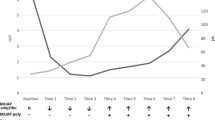Summary
Polymyographic recordings were used to identify the most dystonic muscles suitable for local injection with botulinum toxin in 100 patients with spasmodic torticollis (TS). Rotating TS (72% of the patients) was due to dystonic activity of the splenius muscle ipsilateral to and/or the sternocleidomastoid muscle contralateral to the side of chin deviation. One-third of these patients had also dystonic activation of the contralateral splenius muscle and, rarely, the contralateral trapezius muscle. Ten patients had laterocollis due to dystonic activation of all recorded muscles on one side of the neck. Nine patients had retrocollis due to activity of both splenius muscles and rarely additional activity in both trapezius muscles. The type of dystonic muscle activity was found to be tonic, phasic or tremulous. Besides the evaluation of spontaneous dystonic EMG activity further examination during the “geste antagoniste” or the muscle activity during rotating head movements can provide additional information. It is concluded that polymyography may provide a rationale for identifying the dystonic muscles underlying the different forms of TS. It may prove to be helpful for the successful therapy with botulinum toxin and may be useful in differentiating tremulous torticollis from other types of head tremor.
Similar content being viewed by others
References
Bräutigam W (1954) Grundlagen und Erscheinungsweisen des Torticollis spasticus. Verlaufsuntersuchungen bei 25 Kranken. Nervenarzt 25:451–462
Burke RE, Fahn S, Jankovic J, Marsden CD, Lang AE, Gollomp S, Ilson J (1982) Tardive dystonia: late onset and persistent dystonia caused by antipsychotic drugs. Neurology 32:1335–1346
Couch JR (1976) Dystonia and tremor in spasmodic torticollis. Adv Neurol 14:245–258
Deuschl G (1989) Der idiopathische Torticollis spasmodicus: eine fokale Dystonie. Nervenarzt 60:377–385
Duane DD (1988) Spasmodic torticollis: clinical and biologic features and their implications for focal dystonia. Adv Neurol 50:473–492
Fasshauer K (1983) Klinische und elektromyographische Verlaufsuntersuchungen beim Torticollis spasmodicus. Nervenarzt 54:535–539
Herz E, Glaser GH (1949) Spasmodic torticollis. II. Clinical evaluation. Arch Neurol Psychiatry 61:227–239
Herz E, Hoefer PFA (1949) Spasmodic torticollis. I. Physiologic analysis of involuntary motor activity. Arch Neurol Psychiatry 61:129–136
Jankovic J, Ford J (1988) Blepharospasm and orofacial-cervical dystonia: clinical and pharmacological findings in 100 patients. Ann Neurol 13:402–412
Lücking CH (1980) Phasische und tonische Bewegungsstörung des Torticollis und der Torsionsdystonie. In: Mertens HG, Przuntek H (eds) Verhandlungen der deutschen Gesellschaft für Neurologie, vol 1. Springer, Berlin Heidelberg New York, pp 144–155
Marion MH, Marsden CD (1988) Incidence of dystonia at other sites in patients with spasmodic torticollis. In: Abstract book, Congress of the ISMD, 1988. AKM, Rome, p 108
Matthews WB, Beasly P, Parry-Jones W, Garland G (1978) Spasmodic torticollis: a combined clinical study. J Neurol Neurosurg Psychiatry 41:485–492
Meige H, Feindel E (1902) Les tics et leur traitement. Masson, Paris
Nutt JG, Muenter MD, Melton LJ III, Aronson A, Kurland LT (1988) Epidemiology of dystonia in Rochester, Minnesota. Adv Neurol 50:361–365
Podivinsky F (1969) Torticollis. In: Vinken PJ, Bruyn GW (eds) Diseases of the basal ganglia. (Handbook of clinical neurology, vol 6) North-Holland, Amsterdam, pp 567–603
Poewe W, Schelosky L, Kleedorfer B, Heinen F, Wagner M, Deuschl G (1992) Treatment of spasmodic torticollis with local injection of botulinum toxin. One-year follow-up in 37 patients. J Neurol 239:21–25
Rivest J, Marsden CD (1990) Trunk and head tremor as isolated manifestations of dystonia. Mov Disord 5:60–65
Rothwell JC, Obeso JA, Day BL, Marsden CD (1983) Pathophysiology of dystonias. In: Desmedt JE (ed) Motor control mechanisms in health and disease. Raven Press, New York, pp 851–863
Stell R, Thompson PD, Marsden CD (1988) Botulinum toxin in spasmodic torticollis. J Neurol Neurosurg Psychiatry 51:920–923
Thompson PD, Stell R, Maccabe JJ, Day BL, Rothwell JC, Marsden CD (1990) Electromyography of neck muscles and treatment in spasmodic torticollis. In: Berardelli A, Benecke R, Manfredi M, Marsden CD (eds) Motor disturbances II. Academic Press, London New York, pp 289–304
Tsui JKC, Calne DB (1988) Botulinum toxin in cervical dystonia. Adv Neurol 49:473–478
Tsui JKC, Eisen A, Stoessl AJ, Calne S, Calne DB (1986) Double-blind study of botulinum toxin in spasmodic torticollis. Lancet 11:245–247
Yanagisawa N, Goto A (1971) Dystonia musculorum deformans analysis with electromyography. J Neurol Sci 13:39–65
Author information
Authors and Affiliations
Rights and permissions
About this article
Cite this article
Deuschl, G., Heinen, F., Kleedorfer, B. et al. Clinical and polymyographic investigation of spasmodic torticollis. J Neurol 239, 9–15 (1992). https://doi.org/10.1007/BF00839204
Received:
Revised:
Accepted:
Issue Date:
DOI: https://doi.org/10.1007/BF00839204




